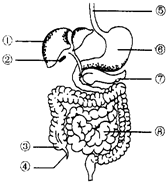如图是人体消化系统模式图,请据图回答问题:
(1)能对蛋白质进行初步消化的器官是______.
(2)分泌的消化液中不含消化酶,但能促进脂肪消化的器官是______.
(3)消化食物和吸收营养物质的主要场所是______.
该场所内有:肝脏分泌的,能够乳化脂肪的______、肠腺分泌的______、⑦______分泌的胰液等消化液.
(4)有吸收功能、无消化功能的器官是______.
(5)能催化蛋白质分解的消化酶来自______、______及______分泌的消化液.

由图可知:图中①肝脏②胆囊③盲肠④阑尾⑤食道⑥胃⑦胰腺⑧小肠.
(1)食物中的蛋白质在⑥胃中开始被初步消化,胃里有胃蛋白酶对蛋白质进行初步消化.
(2)①肝脏是人体最大的消化腺,能够分泌胆汁.分泌的胆汁中不含有消化酶,对脂肪不能进行化学性消化,只能乳化脂肪.
(3)小肠在消化道内最长,长约5-6米;小肠壁的内表面有许多环形皱襞,皱襞上有许多绒毛状的突起,这种突起叫做小肠绒毛.由于环形皱襞和小肠绒毛的存在,使小肠的吸收面积大大增加,可达200平方米以上;小肠绒毛的壁很薄,只有一层上皮细胞构成,而且绒毛中有丰富的毛细血管和毛细淋巴管,这种结构特点有利于小肠吸收营养物质.该场所内有:肝脏分泌的,能够乳化脂肪的胆汁,小肠里有肠液和胰腺分泌的胰液等消化液,是消化的主要场所.
(4)各段消化道的消化能力是不同的:口腔能够初步消化淀粉、胃能够初步消化蛋白质、小肠是消化食物的主要场所,其它各段消化道对食物没有消化能力;消化后的营养物质的吸收也只在部分消化道内进行:小肠是主要的吸收场所,能够吸收大部分的水、无机盐、维生素和全部的氨基酸、葡萄糖、甘油和脂肪酸.胃只能吸收少量的水、无机盐和酒精.大肠是形成粪便的场所,能够吸收少量的水、无机盐和维生素.其他的消化道基本上没有吸收功能.因此在人体消化系统中有吸收无消化功能的器官是大肠.
(5)唾液腺分泌的唾液中含有唾液淀粉酶,能消化淀粉;胃腺分泌胃液,胃液中含有胃蛋白酶,能消化蛋白质;肝脏分泌的胆汁中不含消化酶,但胆汁对脂肪有乳化作用,能把脂肪变成微小颗粒,增加了脂肪与消化酶的接触面积,从而有利于脂肪的消化;肠腺和胰腺分别分泌的肠液、胰液中含有消化糖类、脂肪和蛋白质的酶,能消化糖类、脂肪、蛋白质.因此在消化道内,催化蛋白质分解为可吸收成分的消化液有胃液、肠液、胰液,分别来自胃腺、肠腺、胰腺.
故答案为:(1)胃;(2)肝脏;(3)小肠;胆汁;肠液;胰腺;(4)大肠;(5)胃腺;肠腺;胰腺.
